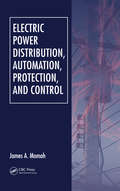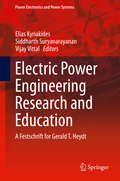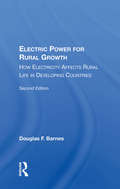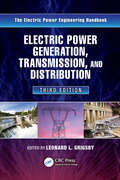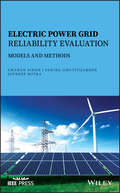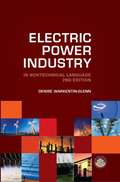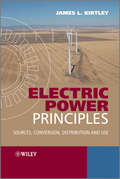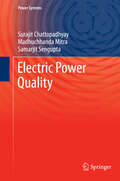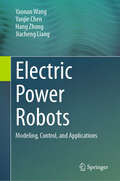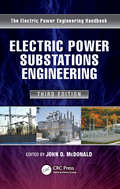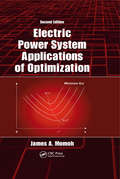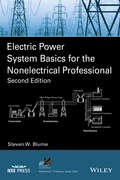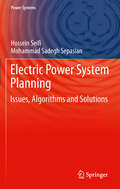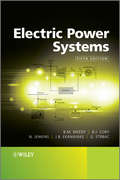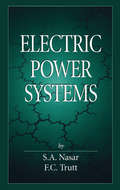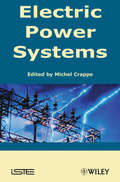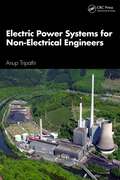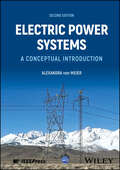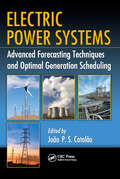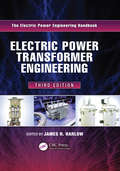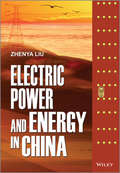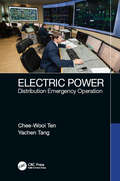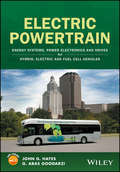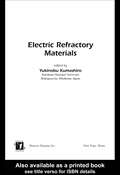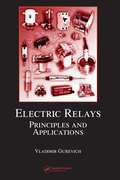- Table View
- List View
Electric Power Distribution, Automation, Protection, and Control
by James A. Momoh<p>New methods for automation and intelligent systems applications, new trends in telecommunications, and a recent focus on renewable energy are reshaping the educational landscape of today's power engineer. Providing a modern and practical vehicle to help students navigate this dynamic terrain, Electric Power Distribution, Automation, Protection, and Control infuses new directions in computation, automation, and control into classical topics in electric power distribution. <p>Ideal for a one-semester course for senior undergraduates or first-year graduate students, this text works systematically through basic distribution principles, renewable energy sources, computational tools and techniques, reliability, maintenance, distribution automation, and telecommunications. Numerous examples, problems, and case studies offer practical insight into the concepts and help build a working knowledge of protection schemes, fault analysis and synthesis, reliability analysis, intelligent automation systems, distribution management systems, and distribution system communications. The author details different renewable energy sources and teaches students how to evaluate them in terms of size, cost, and performance. <p>Guided firmly by the author's wealth of industrial and academic experience, your students will learn the tools and techniques used to design, build, and operate future generations of distribution systems with unparalleled efficiency, robustness, and sustainability.</p>
Electric Power Engineering Research and Education
by Vijay Vittal Elias Kyriakides Siddharth SuryanarayananThis unique volume covers the most compelling areas of advance in electric power engineering, from distributed generation and dispatch to power quality improvement and energy storage. The authors particularly highlight the seminal contributions of Dr. Gerald T. Heydt in the development and teaching of these technological advances, which have impacted the power industry and academia over the last 4 decades in areas such as transmission and distribution engineering, power engineering education, and centers for power engineering research.
Electric Power For Rural Growth: How Electricity Affects Rural Life In Developing Countries
by Douglas F. BarnesThis book offers important historical information on the state of rural electrification in the 1980s. It also summarizes the development of benefit evaluation methods, along with findings from recent research on the impact of rural electrification for development.
Electric Power Generation, Transmission, and Distribution (Electric Power Engineering Series)
by Leonard L. GrigsbyFeaturing contributions from worldwide leaders in the field, the carefully crafted Electric Power Generation, Transmission, and Distribution, Third Edition (part of the five-volume set, The Electric Power Engineering Handbook) provides convenient access to detailed information on a diverse array of power engineering topics. Updates to nearly every chapter keep this book at the forefront of developments in modern power systems, reflecting international standards, practices, and technologies. Topics covered include: Electric power generation: nonconventional methods Electric power generation: conventional methods Transmission system Distribution systems Electric power utilization Power quality L.L. Grigsby, a respected and accomplished authority in power engineering, and section editors Saifur Rahman, Rama Ramakumar, George Karady, Bill Kersting, Andrew Hanson, and Mark Halpin present substantially new and revised material, giving readers up-to-date information on core areas. These include advanced energy technologies, distributed utilities, load characterization and modeling, and power quality issues such as power system harmonics, voltage sags, and power quality monitoring. With six new and 16 fully revised chapters, the book supplies a high level of detail and, more importantly, a tutorial style of writing and use of photographs and graphics to help the reader understand the material. New chapters cover: Water Transmission Line Reliability Methods High Voltage Direct Current Transmission System Advanced Technology High-Temperature Conduction Distribution Short-Circuit Protection Linear Electric Motors A volume in the Electric Power Engineering Handbook, Third Edition. Other volumes in the set: K12648 Power Systems, Third Edition (ISBN: 9781439856338) K13917 Power System Stability and Control, Third Edition (ISBN: 9781439883204) K12650 Electric Power Substations Engineering, Third Edition (ISBN: 9781439856383) K12643 Electric Power Transformer Engineering, Third Edition (ISBN: 9781439856291)
Electric Power Grid Reliability Evaluation: Models and Methods
by Chanan Singh Panida Jirutitijaroen Joydeep MitraThe groundbreaking book that details the fundamentals of reliability modeling and evaluation and introduces new and future technologies Electric Power Grid Reliability Evaluation deals with the effective evaluation of the electric power grid and explores the role that this process plays in the planning and designing of the expansion of the power grid. The book is a guide to the theoretical approaches and processes that underpin the electric power grid and reviews the most current and emerging technologies designed to ensure reliability. The authors—noted experts in the field—also present the algorithms that have been developed for analyzing the soundness of the power grid. A comprehensive resource, the book covers probability theory, stochastic processes, and a frequency-based approach in order to provide a theoretical foundation for reliability analysis. Throughout the book, the concepts presented are explained with illustrative examples that connect with power systems. The authors cover generation adequacy methods, and multi-node analysis which includes both multi-area as well as composite power system reliable evaluation. This important book: • Provides a guide to the basic methods of reliability modeling and evaluation • Contains a helpful review of the background of power system reliability evaluation • Includes information on new technology sources that have the potential to create a more reliable power grid • Addresses renewable energy sources and shows how they affect power outages and blackouts that pose new challenges to the power grid system Written for engineering students and professionals, Electric Power Grid Reliability Evaluation is an essential book that explores the processes and algorithms for creating a sound and reliable power grid.
Electric Power Industry in Nontechnical Language
by Denise Warkentin-GlennIn the second edition of this bestseller, Denise Warkentin-Glenn presents in everyday language the nuances, history, and recent developments of the electric power industry. This new version includes updated information on utilities, merchant plants, rural cooperatives, government entities and more. It also has new chapters covering the 2005 Energy Policy Act, environmental standards, and updates to industry mergers and acquisitions. This important edition gives a comprehensive look at our country's most critical economic driver. Key Features: • Impacts of new regulation • Simple and clear explanations of generation, transmission and governance • How cleaner fuels and new technology are transforming the industry • The newest environmental standards
Electric Power Principles
by James L. KirtleyThis innovative approach to the fundamentals of electric power provides the most rigorous, comprehensive and modern treatment available. To impart a thorough grounding in electric power systems, it begins with an informative discussion on per-unit normalizations, symmetrical components and iterative load flow calculations.Covering important topics within the power system, such as protection and DC transmission, this book looks at both traditional power plants and those used for extracting sustainable energy from wind and sunlight.With classroom-tested material, this book also presents:the principles of electromechanical energy conversion and magnetic circuits; synchronous machines - the most important generators of electric power; power electronics; induction and direct current electric motors. Homework problems with varying levels of difficulty are included at the end of each chapter, and an online solutions manual for tutors is available. A useful Appendix contains a review of elementary network theory.For senior undergraduate and postgraduate students studying advanced electric power systems as well as engineers re-training in this area, this textbook will be an indispensable resource. It will also benefit engineers in electronic power systems, power electronic systems, electric motors and generators, robotics and mechatronics.www.wiley.com/go/kirtley_electric
Electric Power Quality
by Madhuchhanda Mitra Surajit Chattopadhyay Samarjit SenguptaIn the present day deregulated power market electric power quality issues have become great concerns of utilities, end users and manufacturers. Worldwide researches are going on to address those issues. Electric Power Quality has evolved from the researches carried out by the authors. The key features of the book can be highlighted as follows: the contents focuses, on one hand, different power quality issues, their sources and effects and different related standards, which are required for students, researchers and practising engineers and, on the other hand, measurement techniques for different power quality parameters, the content level is designed in such a way that the concepts of different power quality issues in modern power system are built up first, followed by some existing and new measurement methods. This content should attract the students, researchers and practising engineers, the predominant features are Lucid but concise description of the subject, detailed new measurement techniques and Electric Power Quality is intended for graduate, postgraduate and researchers as well as for professionals in the related fields. At the end, a chapter has been added which deals with a concept of generation of harmonics in a power system and its components.
Electric Power Robots: Modeling, Control, and Applications
by Yaonan Wang Yanjie Chen Hang Zhong Jiacheng LiangThis book introduces readers to power robot systems and their applications in the electric power industry. Specifically, the book delves into the research status, technological advancements, challenges encountered, and future potential applications of power operation robots across various stages of power systems. The book provides the latest technological advancements, including in-depth analysis of power operation robots, research directions, and key contributions. Understanding how these robots enhance the monitoring and maintenance efficiency of power systems, mitigate failure risks, and address the challenges of operation and maintenance in complex and large-scale networks is crucial. The topics covered in the book include mobile robot control, navigation, robotic arm control, inverse kinematics algorithms, image recognition, visual calibration, object grasping, and unmanned aerial robotic manipulation. The book is interwoven with practical application tasks typical of power industry, which are essential for mastering the design, application, and development trends of electric power robots. The content is easy to understand and rich in information. This book can serve as a reference for researchers specializing in power system automation, robotics, control theory, and artificial intelligence. For professionals working in power companies, robot manufacturers, system integrators, and related industries, this book offers practical guidance and solutions. For educators teaching courses in electrical engineering, robotics, automation control, and artificial intelligence, this book provides up-to-date knowledge and real-world examples to enhance classroom engagement and teaching quality. For undergraduate students majoring in electrical engineering, automation, robotics, and related fields, this book can serve as supplementary reading material to expand their knowledge base and ignite their passion for science and technology.
Electric Power Substations Engineering (Electrical Engineering Handbook)
by John D. McdonaldThe use of electric power substations in generation, transmission, and distribution remains one of the most challenging and exciting areas of electric power engineering. Recent technological developments have had a tremendous impact on all aspects of substation design and operation. With 80% of its chapters completely revised and two brand-new chapters on energy storage and Smart Grids, Electric Power Substations Engineering, Third Edition provides an extensive updated overview of substations, serving as a reference and guide for both industry and academia. Contributors have written each chapter with detailed design information for electric power engineering professionals and other engineering professionals (e.g., mechanical, civil) who want an overview or specific information on this challenging and important area. This book: Emphasizes the practical application of the technology Includes extensive use of graphics and photographs to visually convey the book’s concepts Provides applicable IEEE industry standards in each chapter Is written by industry experts who have an average of 25 to 30 years of industry experience Presents a new chapter addressing the key role of the substation in Smart Grids Editor John McDonald and this very impressive group of contributors cover all aspects of substations, from the initial concept through design, automation, and operation. The book’s chapters—which delve into physical and cyber-security, commissioning, and energy storage—are written as tutorials and provide references for further reading and study. As with the other volumes in the Electric Power Engineering Handbook series, this book supplies a high level of detail and, more importantly, a tutorial style of writing and use of photographs and graphics to help the reader understand the material. Several chapter authors are members of the IEEE Power & Energy Society (PES) Substations Committee and are the actual experts who are developing the standards that govern all aspects of substations. As a result, this book contains the most recent technological developments in industry practice and standards. Watch John D. McDonald talk about his book A volume in the Electric Power Engineering Handbook, Third Edition. Other volumes in the set: K12642 Electric Power Generation, Transmission, and Distribution, Third Edition (ISBN: 9781439856284) K12648 Power Systems, Third Edition (ISBN: 9781439856338) K13917 Power System Stability and Control, Third Edition (ISBN: 9781439883204) K12643 Electric Power Transformer Engineering, Third Edition (ISBN: 9781439856291)
Electric Power System Applications of Optimization (Second Edition)
by James A. Momoh<p>As the demand for energy continues to grow, optimization has risen to the forefront of power engineering research and development. Continuing in the bestselling tradition of the first edition, Electric Power System Applications of Optimization, Second Edition presents the theoretical background of optimization from a practical power system point of view, exploring advanced techniques, new directions, and continuous application problems. <p>The book provides both the analytical formulation of optimization and various algorithmic issues that arise in the application of various methods in power system planning and operation. The second edition adds new functions involving market programs, pricing, reliability, and advances in intelligent systems with implemented algorithms and illustrative examples. It describes recent developments in the field of Adaptive Critics Design and practical applications of approximate dynamic programming. To round out the coverage, the final chapter combines fundamental theories and theorems from functional optimization, optimal control, and dynamic programming to explain new Adaptive Dynamic Programming concepts and variants. <p>With its one-of-a-kind integration of cornerstone optimization principles with application examples, this second edition propels power engineers to new discoveries in providing optimal supplies of energy.</p>
Electric Power System Basics for the Nonelectrical Professional (2nd Edition)
by Steven W. BlumeThe second edition of Steven W. Blume's bestseller provides a comprehensive treatment of power technology for the non-electrical engineer working in the electric power industry This book aims to give non-electrical professionals a fundamental understanding of large interconnected electrical power systems, better known as the "Power Grid", with regard to terminology, electrical concepts, design considerations, construction practices, industry standards, control room operations for both normal and emergency conditions, maintenance, consumption, telecommunications and safety. The text begins with an overview of the terminology and basic electrical concepts commonly used in the industry then it examines the generation, transmission and distribution of power. Other topics discussed include energy management, conservation of electrical energy, consumption characteristics and regulatory aspects to help readers understand modern electric power systems. This second edition features: New sections on renewable energy, regulatory changes, new measures to improve system reliability, and smart technologies used in the power grid system Updated practical examples, photographs, drawing, and illustrations to help the reader gain a better understanding of the material "Optional supplementary reading" sections within most chapters to elaborate on certain concepts by providing additional detail or background Electric Power System Basics for the Nonelectrical Professional, Second Edition, gives business professionals in the industry and entry-level engineers a strong introduction to power technology in non-technical terms. Steve W. Blume is Founder of Applied Professional Training, Inc., APT Global, LLC, APT College, LLC and APT Corporate Training Services, LLC, USA. Steve is a registered professional engineer and certified NERC Reliability Coordinator with a Master's degree in Electrical Engineering specializing in power and a Bachelor's degree specializing in Telecommunications. He has more than 25 years' experience teaching electric power system basics to non-electrical professionals. Steve's engineering and operations experience includes generation, transmission, distribution, and electrical safety. He is an active senior member in IEEE and has published two books in power systems through IEEE and Wiley.
Electric Power System Planning
by Hossein Seifi Mohammad Sadegh SepasianThe present book addresses various power system planning issues for professionals as well as senior level and postgraduate students. Its emphasis is on long-term issues, although much of the ideas may be used for short and mid-term cases, with some modifications. Back-up materials are provided in twelve appendices of the book. The readers can use the numerous examples presented within the chapters and problems at the end of the chapters, to make sure that the materials are adequately followed up. Based on what Matlab provides as a powerful package for students and professional, some of the examples and the problems are solved in using M-files especially developed and attached for this purpose. This adds a unique feature to the book for in-depth understanding of the materials, sometimes, difficult to apprehend mathematically. Chapter 1 provides an introduction to Power System Planning (PSP) issues and basic principles. As most of PSP problems are modeled as optimization problems, optimization techniques are covered in some details in Chapter 2. Moreover, PSP decision makings are based on both technical and economic considerations, so economic principles are briefly reviewed in Chapter 3. As a basic requirement of PSP studies, the load has to be known. Therefore, load forecasting is presented in Chapter 4. Single bus Generation Expansion Planning (GEP) problem is described in Chapter 5. This study is performed using WASP-IV, developed by International Atomic Energy Agency. The study ignores the grid structure. A Multi-bus GEP problem is discussed in Chapter 6 in which the transmission effects are, somehow, accounted for. The results of single bus GEP is used as an input to this problem. SEP problem is fully presented in Chapter 7. Chapter 8 devotes to Network Expansion Planning (NEP) problem, in which the network is planned. The results of NEP, somehow, fixes the network structure. Some practical considerations and improvements such as multi-voltage cases are discussed in Chapter 9. As NEP study is typically based on some simplifying assumptions and Direct Current Load Flow (DCLF) analysis, detailed Reactive Power Planning (RPP) study is finally presented in Chapter 10, to guarantee acceptable ACLF performance during normal as well as contingency conditions. This, somehow, concludes the basic PSP problem. The changing environments due to power system restructuring dictate some uncertainties on PSP issues. It is shown in Chapter 11 that how these uncertainties can be accounted for. Although is intended to be a text book, PSP is a research oriented topic, too. That is why Chapter 12 is devoted to research trends in PSP. The chapters conclude with a comprehensive example in Chapter 13, showing the step-by-step solution of a practical case.
Electric Power Systems
by N. Jenkins B. J. Cory B. M. Weedy G. Strbac J. B. EkanayakeThe definitive textbook for Power Systems students, providing a grounding in essential power system theory while also focusing on practical power engineering applications.Electric Power Systems has been an essential book in power systems engineering for over thirty years. Bringing the content firmly up-to-date whilst still retaining the flavour of Weedy's extremely popular original, this Fifth Edition has been revised by experts Nick Jenkins, Janaka Ekanayake and Goran Strbac. This wide-ranging text still covers all of the fundamental power systems subjects but is now expanded to cover increasingly important topics like climate change and renewable power generation. Updated material includes an analysis of today's markets and an examination of the current economic state of power generation. The physical limits of power systems equipment - currently being tested by the huge demand for power - is explored, and greater attention is paid to power electronics, voltage source and power system components, amongst a host of other updates and revisions.Supplies an updated chapter on power system economics and management issues and extended coverage of power system components. Also expanded information on power electronics and voltage source, including VSC HVDC and FACTS. Updated to take into account the challenges posed by different world markets, and pays greater attention to up-to-date renewable power generation methods such as wind power. Includes modernized presentation and greater use of examples to appeal to today's students, also retains the end of chapter questions to assist with the learning process. Also shows students how to apply calculation techniques.
Electric Power Systems
by Syed A. Nasar F. C TruttThe field of electrical engineering has become increasingly diversified, resulting in a spectrum of emerging topics - from microelectromechanics to light-wave technology. Keeping pace with progressing technology, and covering the scope of related subjects, Electric Power Systems provides introductory, fundamental knowledge in several areas. The tex
Electric Power Systems (Wiley-iste Ser.)
by Michel CrappeThe creation of a European liberalized electricity internal market and EU commitments for the reduction of greenhouse gas emissions (Kyoto Protocol) and for the use of renewable energy generation technologies induce new important constraints and problems on the electric power systems in Europe. This then creates the need for more research and development to engage with these new challenges in order to preserve the reliability of these systems. This book aims to provide advanced tools, covering major aspects, for people involved with such research and development. Split into two parts (the first covering the operation and control of electric power systems and the second the stability and defence of electric power systems), this book gathers together contributions from numerous well-known European specialists in academia and the electrical industry and will be an illuminating read for those involved in this field or who have some knowledge of the fundamental notions.
Electric Power Systems for Non-Electrical Engineers
by Anup Kumar TripathiThis book explains the electrical power systems for non-electrical engineers and includes topics like electrical energy systems, electrical power systems structure, single-phase AC circuit fundamentals and three-phase systems, power system modeling, power system representation, power system operation, power flow analysis, economic operation of power systems, power system fault analysis, power system protection fundamentals, and so forth. Examples have been provided to clarify the description, and review questions are provided at the end of each chapter.Features: Provides a simplified description of fundamentals of electrical energy systems and structure of electrical power systems for non-electrical engineers. Gives a detailed description of AC circuit fundamentals and three-phase systems. Describes power system modeling and power system representation. Covers power system operation, power flow analysis, and fundamentals of economic operation of power systems. Discusses power system fault analysis and fundamentals of power system protection with examples, and also includes renewable energy systems. This book has been aimed at senior undergraduate and graduate students of non-electrical engineering background.
Electric Power Systems: A Conceptual Introduction (Wiley Survival Guides In Engineering And Science Ser. #8)
by Alexandra von MeierDiscover the technology for producing and delivering electricity in this easily accessible introduction to power systems Electric Power Systems underlie virtually every aspect of modern life. In the face of an unprecedented transition from fossil fuels to clean energy, it has never been more essential for engineers and other professionals from diverse disciplines to understand the electric grid and help chart its future. Since its original publication, Electric Power Systems has served as a uniquely accessible and qualitative introduction to the subject, offering a foundational overview with an emphasis on key concepts and building physical intuition. Now revised and updated to bring even greater rigor and incorporate the latest technologies, it remains an indispensable introduction to this vital subject. Readers of the revised and expanded second edition of Electric Power Systems will also find: End-of-chapter problems to facilitate and reinforce learning New discussions of subjects including load frequency control, protection, voltage stability, and many others More quantitative treatment of topics such as voltage regulation, power flow analysis, generator and transformer modeling with numerical examples Entirely new chapters on generation and storage resources, power electronics, and the analysis of transmission lines Electric Power Systems is an ideal textbook for graduate and advanced undergraduate students in engineering, as well as for a broad range of professionals, such as computer and data scientists, solar and wind energy manufacturers and installers, energy storage providers, economists, policy makers, legal and regulatory staff, and advocacy organizations.
Electric Power Systems: Advanced Forecasting Techniques and Optimal Generation Scheduling
by João P. S. CatalãoElectric Power Systems: Advanced Forecasting Techniques and Optimal Generation Scheduling helps readers develop their skills in modeling, simulating, and optimizing electric power systems. Carefully balancing theory and practice, it presents novel, cutting-edge developments in forecasting and scheduling. The focus is on understanding and solving pivotal problems in the management of electric power generation systems. Methods for Coping with Uncertainty and Risk in Electric Power Generation Outlining real-world problems, the book begins with an overview of electric power generation systems. Since the ability to cope with uncertainty and risk is crucial for power generating companies, the second part of the book examines the latest methods and models for self-scheduling, load forecasting, short-term electricity price forecasting, and wind power forecasting. Toward Optimal Coordination between Hydro, Thermal, and Wind Power Using case studies, the third part of the book investigates how to achieve the most favorable use of available energy sources. Chapters in this section discuss price-based scheduling for generating companies, optimal scheduling of a hydro producer, hydro-thermal coordination, unit commitment with wind generators, and optimal optimization of multigeneration systems. Written in a pedagogical style that will appeal to graduate students, the book also expands on research results that are useful for engineers and researchers. It presents the latest techniques in increasingly important areas of power system operations and planning.
Electric Power Transformer Engineering
by Alice Wilmere Norton ShawElectric Power Transformer Engineering, Third Edition expounds the latest information and developments to engineers who are familiar with basic principles and applications, perhaps including a hands-on working knowledge of power transformers. Targeting all from the merely curious to seasoned professionals and acknowledged experts, its content is structured to enable readers to easily access essential material in order to appreciate the many facets of an electric power transformer. Topically structured in three parts, the book: Illustrates for electrical engineers the relevant theories and principles (concepts and mathematics) of power transformers Devotes complete chapters to each of 10 particular embodiments of power transformers, including power, distribution, phase-shifting, rectifier, dry-type, and instrument transformers, as well as step-voltage regulators, constant-voltage transformers, transformers for wind turbine generators and photovoltaic applications, and reactors Addresses 14 ancillary topics including insulation, bushings, load tap changers, thermal performance, testing, protection, audible sound, failure analysis, installation and maintenance and more As with the other books in the series, this one supplies a high level of detail and, more importantly, a tutorial style of writing and use of photographs and graphics to help the reader understand the material. Important chapters have been retained from the second edition; most have been significantly expanded and updated for this third installment. Each chapter is replete with photographs, equations, and tabular data, and this edition includes a new chapter on transformers for use with wind turbine generators and distributed photovoltaic arrays. Jim Harlow and his esteemed group of contributors offer a glimpse into the enthusiastic community of power transformer engineers responsible for this outstanding and best-selling work. A volume in the Electric Power Engineering Handbook, Third Edition. Other volumes in the set: K12642 Electric Power Generation, Transmission, and Distribution, Third Edition (ISBN: 9781439856284) K12648 Power Systems, Third Edition (ISBN: 9781439856338) K13917 Power System Stability and Control, Third Edition (9781439883204) K12650 Electric Power Substations Engineering, Third Edition (9781439856383) Watch James H. Harlow's talk about his book: Part One: http://youtu.be/fZNe9L4cux0 Part Two: http://youtu.be/y9ULZ9IM0jE Part Three: http://youtu.be/nqWMjK7Z_dg
Electric Power and Energy in China
by Zhenya LiuThe acute energy problems facing China today are characterized by their own histories and realities. Some have come about because of China's energy endowment and stage of development, while others have been created by a combination of domestic and global factors. Some are the results of an accumulation of longstanding contradictions, while others are new challenges posed by the new order. There are no "miracle cures" to solve these problems instantly. What is needed is a tireless enquiry, with goals, planning and procedures, guided by a clear energy strategy. With China's increasing dependence on foreign energy sources, and the global energy situation and greenhouse gas issue exerting an increasingly prohibiting effect on China's energy development, energy diplomacy has become an important component of Chinese diplomatic affairs. Based on a "broad energy outlook", this book studies and analyzes China's energy issues and energy strategies from the perspective of electric power. Discusses a variety of issues, including energy transportation and allocation, end-user consumption, markets, early warning and emergency, technical innovation As a leading player in the power and energy area, China’s strategies attracts global attention Proposes the innovative idea of "Macro Energy Perspective" As a key player in China's energy industrial circle, the author's perspective can help global audiences to understand China's energy strategies better Electric Power and Energy in China is ideal for government energy policy makers, engineers, scientists and enterprise managers to understand China’s strategy in electric power and energy. It is also a good reference for energy economics researchers, consultants and university students.
Electric Power: Distribution Emergency Operation
by Chee-Wooi Ten Yachen TangProvides the fundamentals of distribution emergency operation using graph-theoretic approach and exploration of subsystem(s) that address the operational aspects of fault occurrence to determine the possible feeder reconfiguration. Topics include: (1) Data extraction from geographic information systems (GIS), (2) Graph modeling of distribution feeders, (3) Programming for backward/forward sweeping unbalanced power flow, (4) Short circuit analysis and fault localization, (5) Fault isolation and service restoration, (6) Outage management and crew coordination, (7) Trouble call tickets and escalation to search for fault, and (8) Emerging topics of distribution management systems (DMS).
Electric Powertrain: Energy Systems, Power Electronics and Drives for Hybrid, Electric and Fuel Cell Vehicles
by John G. Hayes G. Abas GoodarziEmpowers engineering professionals and students with the knowledge and skills required to engineer electric vehicle powertrain architectures, energy storage systems, power electronics converters and electric drives. The modern electric powertrain is relatively new for the automotive industry, and engineers are challenged with designing affordable, efficient and high-performance electric powertrains as the industry undergoes a technological evolution. Co-authored by two electric vehicle (EV) engineers with decades of experience designing and putting into production all of the powertrain technologies presented, this book provides readers with the hands-on knowledge, skills and expertise they need to rise to that challenge.This four-part practical guide provides a comprehensive review of battery, hybrid and fuel cell EV systems and the associated energy sources, power electronics, machines, and drives. The first part of the book begins with a historical overview of electromobility and the related environmental impacts motivating the development of the electric powertrain. Vehicular requirements for electromechanical propulsion are then presented. Battery electric vehicles (BEV), fuel cell electric vehicles (FCEV), and conventional and hybrid electrical vehicles (HEV) are then described, contrasted and compared for vehicle propulsion. The second part of the book features in-depth analysis of the electric powertrain traction machines, with a particular focus on the induction machine and the surface- and interior-permanent magnet ac machines. The brushed dc machine is also considered due to its ease of operation and understanding, and its historical place, especially as the traction machine on NASA’s Mars rovers. The third part of the book features the theory and applications for the propulsion, charging, accessory, and auxiliary power electronics converters. Chapters are presented on isolated and non-isolated dc-dc converters, traction inverters, and battery charging. The fourth part presents the introductory and applied electromagnetism required as a foundation throughout the book. • Introduces and holistically integrates the key EV powertrain technologies.• Provides a comprehensive overview of existing and emerging automotive solutions.• Provides experience-based expertise for vehicular and powertrain system and sub-system level study, design, and optimization.• Presents many examples of powertrain technologies from leading manufacturers.• Discusses the dc traction machines of the Mars rovers, the ultimate EVs from NASA.• Investigates the environmental motivating factors and impacts of electromobility.• Presents a structured university teaching stream from introductory undergraduate to postgraduate.• Includes real-world problems and assignments of use to design engineers, researchers, and students alike.• Features a companion website with numerous references, problems, solutions, and practical assignments.• Includes introductory material throughout the book for the general scientific reader.• Contains essential reading for government regulators and policy makers.Electric Powertrain: Energy Systems, Power Electronics and Drives for Hybrid, Electric and Fuel Cell Vehicles is an important professional resource for practitioners and researchers in the battery, hybrid, and fuel cell EV transportation industry. The book is a structured holistic textbook for the teaching of the fundamental theories and applications of energy sources, power electronics, and electric machines and drives to engineering undergraduate and postgraduate students.Textbook Structure and Suggested Teaching CurriculumThis is primarily an engineering textbook covering the automotive powertrain, energy storage and energy conversion, power electronics, and electrical m
Electric Refractory Materials
by Yukinobu KumashiroAn exploration of electric refractory materials, this book covers developments of blue light-emitting diodes using GaN-based nitrides for laser and high-temperature and -frequency devices. Electric Refractory Materials introduces growth and evaluation standards of films and bulk crystals, with consideration of band structure, surface electronic structure, and lattice vibrations. It also covers heat capacity and thermal conductivity, irradiation properties, and selective surfaces. Focusing on diamond material, the book examines its synthesis and characterization as well as its electrical, optical, and conductive properties. The book also discusses the use of silicon carbide, boron compounds, and other material used in electronic and light-emitting devices.
Electric Relays: Principles and Applications (Electrical and Computer Engineering #Vol. 130)
by Vladimir GurevichElectric relays pervade the electronics that dominate our world. They exist in many forms, fulfill many roles, and each have their own behavioral nuances and peculiarities. To date, there exists no comprehensive reference surveying the broad spectrum of electric relays, save one-Electric Relays: Principles and Applications. This ambitious work is not only unique in its scope, but also in its practical approach that focuses on the operational and functional aspects rather than on theory and mathematics.Accomplished engineer Dr. Vladimir Gurevich builds the presentation from first principles, unfolding the concepts and constructions via discussion of their historical development from the earliest ideas to modern technologies. He uses a show-not-tell approach that employs nearly 1300 illustrations and reveals valuable insight based on his extensive experience in the field. The book begins with the basic principles of relay construction and the major functional parts, such as contact and magnetic systems. Then, it devotes individual chapters to the various types of relays. The author describes the principles of function and construction for each type as well as features of several relays belonging to a type that operate on different principles.Remarkably thorough and uniquely practical, Electric Relays: Principles and Applications serves as the perfect introduction to the plethora of electric relays and offers a quick-reference guide for the experienced engineer.
